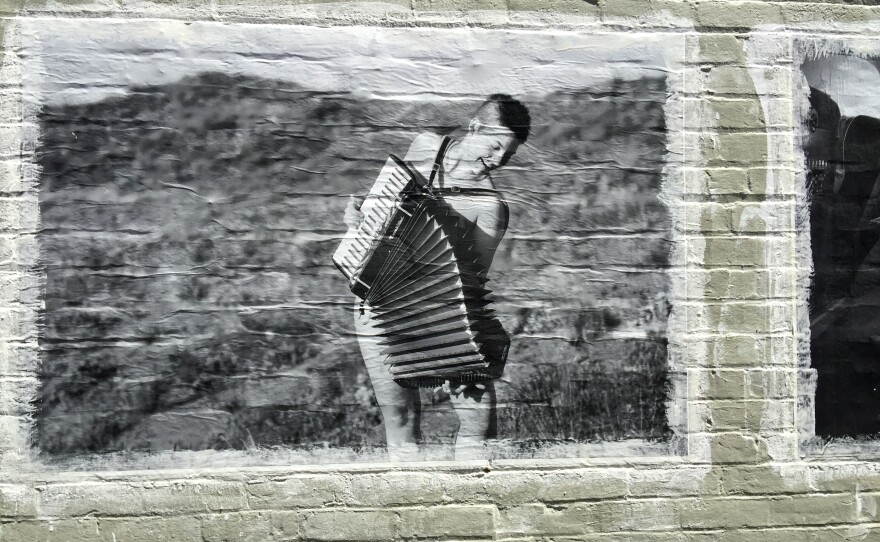The world of photography is undergoing massive change. We are taking - and uploading - more photographs than ever before. But, printing of photographs has dropped precipitously.
Nonetheless, JPR’s Michael Joyce has come across a public art project in Arcata, California that is celebrating the printed photograph in a very big way.
I’m standing in the alleyway near Don’s Donuts in Arcata and … I’m riveted.
I’m surrounded on both sides by these huge black and white photographs, each around three feet tall and about four or five feet wide. The photos feel as if they’re part of the bricks but they’re printed on paper that’s been plastered to the wall with wheat paste made of flour and water. Extra paste gathers on the edges creating a plaster-like texture that seems to act like a frame.
The effect is kind of paradoxical because the old school pasting technique, combined with the old school black and white prints, is nostalgic, but the overall effect feels fresh and hip. It makes me want to linger.
Just like Chuck Johnson did.
“I was just strolling in Arcata and saw these photos in the alleyway and just stopped. I was instantly drawn to them. I didn’t know what it was, who did it, I immediately wanted to do it!”
You could call Chuck Johnson a jack-of-all-arts. He’s a photographer, videographer, recording engineer, and bass player. So, what was the allure?
“It wasn’t online,” he says. “And it wasn’t in a frame, it was just SPLAT! And that added to the images. They were just exposed and I was just really drawn to that.”
The Big Picture project was actually started in Colorado by Denver-based photographer Mark Sink. His goal was to build up an online collection of photos so they could be shared via email and then pasted up in public spaces around the world.
That’s how Arcata photographer Daniel Southard found the project and got it up and running in the alley behind Northtown Bookstore, before handing it over to Chuck Johnson. Chuck’s had three installations since the beginning of the year and gradually transitioned away from the Colorado photos, and now’s including more local photographers like Andrew Goff.
“I don’t consider myself a photographer,” Goff says. “Just a guy with a camera.”
Andrew carries a camera because he’s a print journalist; nonetheless his photo of three zebras running past some redwood trees seems to make everyone do a double-take.“I wish I could say I planned the shot out, but no, it was just zebras running away far off in the distance,” he says. “And it’s kind of a surreal experience. It is the foliage of coastal Humboldt County, but here is an animal that doesn’t normally belong there.”
Apparently some fashion designers from Southern California keep the zebras at their sprawling Humboldt county ranch. But most of the photos clearly tap into a more local vibe like pyramids of drying lumber, pigeons in the town square, old typewriters, and a fair share of nudes. The photos are so big they almost demand that you stop. Again, curator Chuck Johnson.
“People are used to squinting at a screen. Or it it’s a photo in a coffee shop it’s12 inches tall. So to see these things large on a wall it makes you pause.”
And this might give you pause as well: there are an estimated one billion uploads of photographs every day, with Facebook alone, accounting for about a third of that. The Professional Photographers of America report that two-thirds of us store our pictures exclusively in digital form, and only about half of us have printed a snapshot in the past year.
Our technology has rendered the very notion of a photo wheat-pasted to a brick wall to be outlandish. As is taking fine black and white photography out of the gallery and on to the streets. It’s an audacious move that appeals to most of the people I spoke with, like this young woman named Jessie who was out vaping in the alley during her lunch break.
“I think it makes a bland, kinda dirty alley nice,” she says. “And it brings some local artists and gets their work out. I like it!”
Chuck Johnson says people have begun to interact with the exhibit in some unexpected ways.
“Some of the street people have now assigned themselves to protect the photos and I’ve seen them explaining what the project is to people,” he says. “There’s like this underlying sense of community pride almost.”
And Chuck and the other photographers expected their photos would be tagged more than they have been. He says most of the graffiti has been either minimal or actually pretty interesting.
“I certainly appreciate some nice graffiti if it is what I think it is adding to the image. Some people have added some really cool things that adds an interactivity. I mean that is part of it.”
And it’s that interactivity that often makes public art so compelling. And thanks to the Big Picture movement - which now has spread across the country and into Europe, Japan and the Caribbean - print photography has secured its place in the public art scene.






